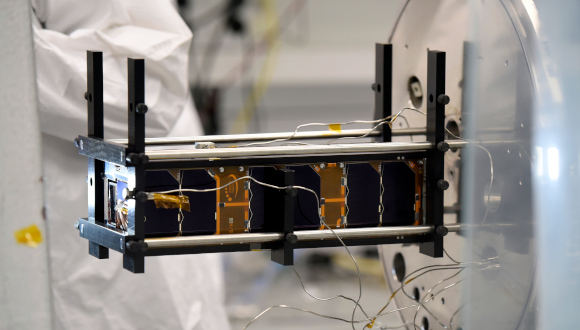TAU builds and plans to launch a small satellite into orbit

The nanosatellite, entirely designed and assembled on the University campus, will measure cosmic radiation around the earth
Support this researchThe TAU-SAT1 nanosatellite, approximately the size of a shoebox, is currently undergoing pre-flight testing at the Japanese space agency JAXA prior to a planned launch by NASA in the first quarter of 2021. TAU-SAT1 was entirely devised, developed, assembled, and tested at Tel Aviv University’s Nanosatellite Center, an interdisciplinary endeavor of the University’s Iby and Aladar Fleischman Faculty of Engineering, Raymond & Beverly Sackler Faculty of Exact Sciences, and Porter School of Environmental Studies.
“TAU-SAT1 is the first nanosatellite designed, built and tested in an Israeli university, and the entire process, from conception through design, software development and testing, was done at TAU,” explains Dr. Ofer Amrani, head of TAU’s minisatellite lab. While other universities in Israel, including The Technion, Ben-Gurion University, and Ariel University, are investing in similar space projects, the TAU satellite will be the first to enter the Earth’s orbit.
TAU-SAT1 is a research satellite and will conduct several experiments while in orbit, including the measurement of cosmic radiation in space.
“We know that that there are high-energy particles moving through space that originate from cosmic radiation,” says Dr. Meir Ariel, director of the University’s Nanosatellite Center. “Our scientific task is to monitor this radiation, and to measure the flux of these particles and their products. To this end, we incorporated a number of experiments into the satellite, which were developed by the Space Environment Department at the Soreq Nuclear Research Center.”
One challenge was to extract the data collected by the TAU-SAT1 satellite. The satellite will complete an orbit around the Earth every 90 minutes. “In order to collect data, we built a satellite station on the roof of the engineering building,” says Dr. Amrani. “Our station, which also serves as an amateur radio station, includes a number of antennas and an automated control system. When TAU-SAT1 passes over Israel, the antennas will track the satellite’s orbit and a process of data transmission will occur between the satellite and the station.”
The satellite is expected to be active for several months. Because it has no engine, its trajectory will fade over time as the result of atmospheric drag. It will eventually burn up in the atmosphere and return to the Earth as dust.
The launch of the TAU-SAT1 nanosatellite is just TAU’s first step on its way to joining the “new space” revolution, Dr. Amrani says. “The idea behind the new space revolution is to open space up to civilians as well. In the not-too-distant past, satellites involved a very expensive development process that took many years and required the involvement of large and cumbersome governmental systems. We were able to complete the planning, building, and testing of our own satellite in less than two years. Moreover, we built the infrastructure on our own – from the cleanrooms, to the various testing facilities such as the thermal vacuum chamber, to the receiving and transmission station we placed on the roof. Now that the infrastructure is ready, we can begin to develop TAU-SAT2.
“The idea is that any researcher and any student, from any faculty at TAU or outside of it, will be able to plan and launch experiments into space in the future – even without being an expert in the field,” Dr. Amrani concludes.